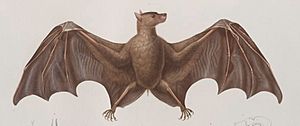Bare-backed fruit bat facts for kids
Quick facts for kids Bare-backed fruit bat |
|
|---|---|
 |
|
| Conservation status | |
| Scientific classification | |
| Genus: |
Dobsonia
|
| Species: |
moluccensis
|
| Synonyms | |
|
|
The bare-backed fruit bat (Dobsonia moluccensis) is a fruit bat in the family Pteropodidae.
Contents
Taxonomy and etymology
It was described as a new species in 1830 by Jean René Constant Quoy and Joseph Paul Gaimard They placed it in the now-defunct bat genus Hypoderma, with the scientific name H. moluccensis. Its species name "moluccensis" means "belonging to the Moluccas," which is where the species is found.
Description
Its fur is brown and its feet have distinctive white claws. It is smaller than the New Guinea naked-backed fruit bat. Males weigh 380–500 g (0.84–1.10 lb) while females weigh 325–525 g (0.717–1.157 lb). Its ears are pointed, and its second digits lack claws, unlike flying foxes. Its wings attach at the back along the spine rather than along the sides of the body.
Biology and ecology
The bare-backed fruit bat is a seasonal breeder, with the mating season from April to June. Females give birth from mid-August through November.
Range and habitat
The bare-backed fruit bat is found in Indonesia, East Timor, Papua New Guinea, and Australia. It has been documented from 0–2,700 m (0–8,858 ft) above sea level.
Conservation
As of 2016, it is considered a least-concern species by the IUCN. It meets the criteria for this assessment because it has a wide geographic range, and it is locally abundant.
Images for kids
See also
 In Spanish: Dobsonia moluccensis para niños
In Spanish: Dobsonia moluccensis para niños


